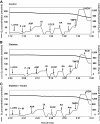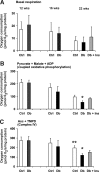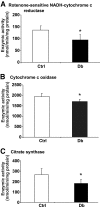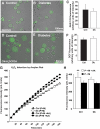Mitochondrial respiratory chain dysfunction in dorsal root ganglia of streptozotocin-induced diabetic rats and its correction by insulin treatment
- PMID: 20103706
- PMCID: PMC2844817
- DOI: 10.2337/db09-1299
Mitochondrial respiratory chain dysfunction in dorsal root ganglia of streptozotocin-induced diabetic rats and its correction by insulin treatment
Abstract
Objective: Impairments in mitochondrial physiology may play a role in diabetic sensory neuropathy. We tested the hypothesis that mitochondrial dysfunction in sensory neurons is due to abnormal mitochondrial respiratory function.
Research design and methods: Rates of oxygen consumption were measured in mitochondria from dorsal root ganglia (DRG) of 12- to- 22-week streptozotocin (STZ)-induced diabetic rats, diabetic rats treated with insulin, and age-matched controls. Activities and expression of components of mitochondrial complexes and reactive oxygen species (ROS) were analyzed.
Results: Rates of coupled respiration with pyruvate + malate (P + M) and with ascorbate + TMPD (Asc + TMPD) in DRG were unchanged after 12 weeks of diabetes. By 22 weeks of diabetes, respiration with P + M was significantly decreased by 31-44% and with Asc + TMPD by 29-39% compared with control. Attenuated mitochondrial respiratory activity of STZ-diabetic rats was significantly improved by insulin that did not correct other indices of diabetes. Activities of mitochondrial complexes I and IV and the Krebs cycle enzyme, citrate synthase, were decreased in mitochondria from DRG of 22-week STZ-diabetic rats compared with control. ROS levels in perikarya of DRG neurons were not altered by diabetes, but ROS generation from mitochondria treated with antimycin A was diminished compared with control. Reduced mitochondrial respiratory function was associated with downregulation of expression of mitochondrial proteins.
Conclusions: Mitochondrial dysfunction in sensory neurons from type 1 diabetic rats is associated with impaired rates of respiratory activity and occurs without a significant rise in perikaryal ROS.
Figures






References
-
- Yagihashi S: Pathogenetic mechanisms of diabetic neuropathy: lessons from animal models. J Peripher Nerv Syst 1997; 2: 113– 132 - PubMed
-
- Malik RA, Tesfaye S, Newrick PG, Walker D, Rajbhandari SM, Siddique I, Sharma AK, Boulton AJ, King RH, Thomas PK, Ward JD: Sural nerve pathology in diabetic patients with minimal but progressive neuropathy. Diabetologia 2005; 48: 578– 585 - PubMed
-
- Obrosova IG: Increased sorbitol pathway activity generates oxidative stress in tissue sites for diabetic complications. Antioxid Redox Signal 2005; 7: 1543– 1552 - PubMed
-
- Thornalley PJ: Glycation in diabetic neuropathy: characteristics, consequences, causes, and therapeutic options. Int Rev Neurobiol 2002; 50: 37– 57 - PubMed
-
- Nishikawa T, Edelstein D, Du XL, Yamagishi S, Matsumura T, Kaneda Y, Yorek MA, Beebe D, Oates PJ, Hammes HP, Giardino I, Brownlee M: Normalizing mitochondrial superoxide production blocks three pathways of hyperglycaemic damage. Nature 2000; 404: 787– 790 - PubMed
Publication types
MeSH terms
Substances
Grants and funding
LinkOut - more resources
Full Text Sources
Other Literature Sources
Medical
Molecular Biology Databases
Miscellaneous

